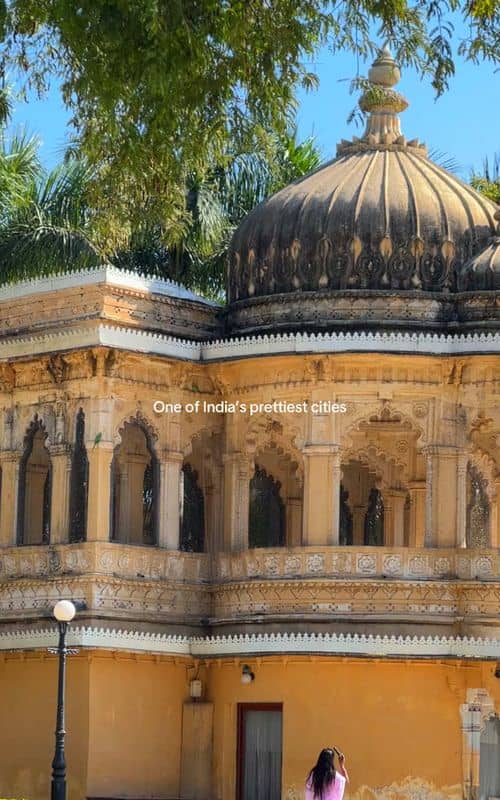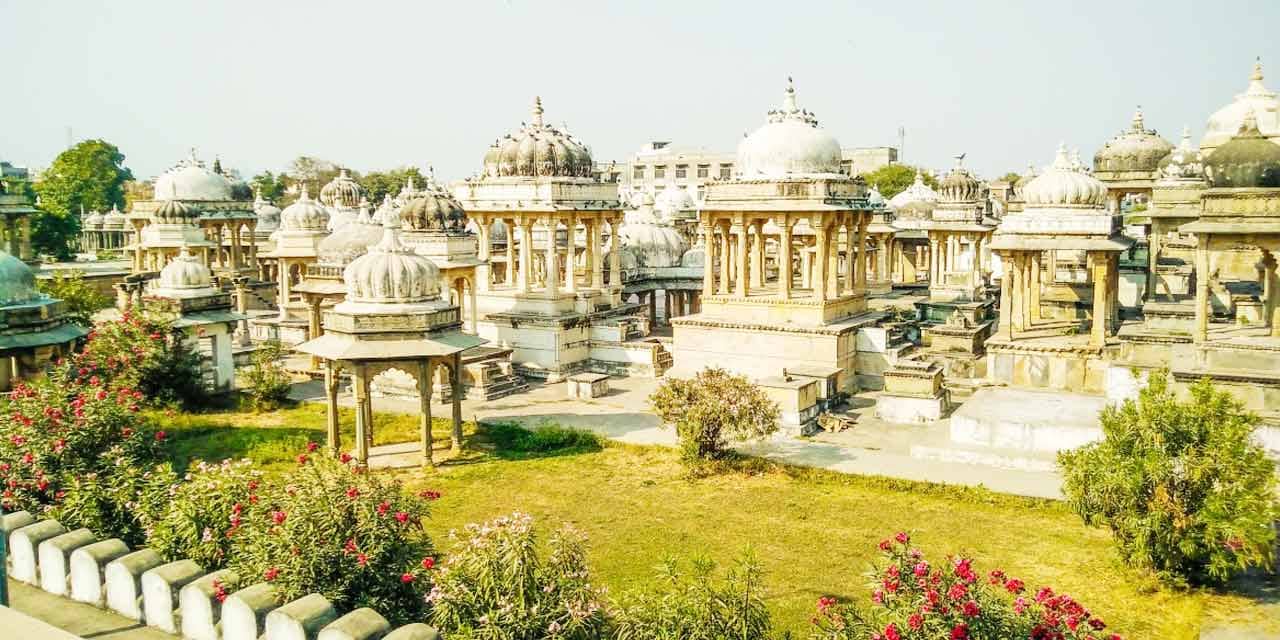Ahar Archaeological Museum
Explore ancient civilizations and royal legacies at Ahar Museum, home to 4000-year-old artifacts and majestic cenotaphs of Mewar rulers.
Highlights
Must-see attractions

Social
From TikTok & Reddit
Best Time
Fewer crowds, more peaceful
Ahar Archaeological Museum
Best Time
Fewer crowds, more peaceful
Highlights
Must-see attractions
Explore ancient civilizations and royal legacies at Ahar Museum, home to 4000-year-old artifacts and majestic cenotaphs of Mewar rulers.
"An underrated historical treasure with a deep royal legacy, offering insights into Rajasthan's ancient past. "
🎟️ Affordable Entry
Tickets are very reasonably priced, around ₹30 for Indians and ₹100 for foreigners.
🚗 Parking Available
Street-side parking is generally available near the museum.
Highlights
Discover the most iconic attractions and experiences
Ahar Cenotaphs
Adjacent to the museum
Majestic marble cenotaphs (chhatris) honoring Mewar's Maharanas. A serene and historically significant site.
Ancient Artifacts
Museum galleries
Pottery, sculptures, and tools from the 4000-year-old Ahar civilization. A walk through India's ancient past.

Royal Legacy
Museum and cenotaphs
Discover the deep royal heritage of Rajasthan beyond the typical tourist trail.
Plans like a pro.
Thinks like you
Planning Your Visit
Uncover Ancient Roots
Timing is Key
Best Times
Insider Tips
from TikTok, Instagram & Reddit
🎟️ Affordable Entry
Tickets are very reasonably priced, around ₹30 for Indians and ₹100 for foreigners.
🚗 Parking Available
Street-side parking is generally available near the museum.
⏳ Time for History
Allow 1-3 hours to truly appreciate the ancient artifacts and royal history.
🗺️ Ask About Ruins
Inquire with guards about nearby ancient ruins of the Ahar civilization with Shiv temples.
Tips
from all over the internet
🎟️ Affordable Entry
Tickets are very reasonably priced, around ₹30 for Indians and ₹100 for foreigners.
🚗 Parking Available
Street-side parking is generally available near the museum.
⏳ Time for History
Allow 1-3 hours to truly appreciate the ancient artifacts and royal history.
🗺️ Ask About Ruins
Inquire with guards about nearby ancient ruins of the Ahar civilization with Shiv temples.
What Travellers Say
Reviews Summary
Ahar Museum is praised as an underrated historical gem, offering a deep dive into the ancient Ahar civilization and the royal legacy of Mewar through its artifacts and cenotaphs. Visitors appreciate its affordability and historical significance, though some note it's less crowded than other Udaipur attractions.
"Ahar Museum is the place where Ahar people lived. Most of the artifacts from 5000BCE to 2000 BCE. So, it is an old civilization. Some other statue type artifacts are from the 10th century as well. So, if you have an interest in museums, please visit. Tickets price is about 20 rupees for Indians.
If you are just leisurely visiting it, would take about 30-45 mins. If you observe and read every detail, it would take around 2-3 hours"
Parth Patel
"Underrated Historical Treasure with Deep Royal Legacy🩵
Ahar Museum is one of Udaipur's lesser-known but truly fascinating historical spots. Located just a few kilometers from the city center, it houses the cenotaphs (chhatris) of the Maharanas of Mewar along with an archaeological museum that gives a deep insight into Rajasthan's royal and ancient heritage.
The museum part has an interesting collection of artifacts dating back to 4000 years — including pottery, sculptures, and tools from the ancient Ahar civilization. It's a walk through time, especially if you’re into archaeology.
Udaipur isn’t just about lakes and palaces — Ahar Museum is proof of the city’s ancient depth and royal soul. It deserves way more attention than it gets."
NvN Mali
"The Ahar archaeological site is a significant Chalcolithic (Copper Age) settlement associated with the Ahar-Banas culture. It is known for its distinctive pottery, copper tools, and evidence of early agricultural practices. The site provides insights into a rural Chalcolithic culture that existed alongside the Indus Valley Civilization."
Shreya Jain
What People Like
What People Dislike
Frequently Asked Questions
🚇 🗺️ Getting There
Ahar Archaeological Museum is located just a few kilometers from Udaipur's city center. You can easily reach it by auto-rickshaw or taxi. Many travelers mention it's a short ride from the main tourist areas.
While direct public bus routes might be limited, auto-rickshaws and taxis are readily available and affordable for reaching the museum from anywhere in Udaipur.
For solo travelers on a budget, an auto-rickshaw is a great option. Negotiate the fare beforehand or use ride-sharing apps if available in Udaipur.
Yes, the museum is close to the city center, making it easy to combine with visits to Udaipur's famous lakes and palaces. Some reviews mention asking guards about nearby ancient ruins as well.
Yes, street-side parking is available near the museum, which is convenient if you're traveling by your own vehicle or a hired car.
🎫 🎫 Tickets & Entry
Ticket prices are very affordable. For Indian tourists, it's around ₹30, and for foreign tourists, it's approximately ₹100.
The museum is generally open during daylight hours, but it's advisable to check the exact timings locally or upon arrival as they can vary.
No, advance booking is typically not required for Ahar Museum. Tickets can be purchased at the entrance.
While specific discounts aren't widely advertised, the current prices are already very low, making it an accessible attraction for all visitors.
Information on student discounts is not readily available, but the standard entry fees are quite low. It's always worth asking at the ticket counter.
🎫 🏛️ Onsite Experience
The museum displays artifacts from the ancient Ahar civilization (pottery, tools) dating back 4000 years, as well as sculptures from the 10th century. Adjacent are the cenotaphs of Mewar's royal rulers.
A leisurely visit can take 1-3 hours, especially if you're interested in archaeology. Some visitors find 30-45 minutes sufficient for a quick overview.
Absolutely! It's considered an underrated historical treasure offering deep insights into Rajasthan's royal and ancient heritage, distinct from typical museum narratives.
Guided tours are not commonly advertised. However, the information provided on the artifacts and the cenotaphs is usually sufficient for an informative visit.
The Ahar culture was a Chalcolithic (Copper Age) civilization in southeastern Rajasthan, contemporary with the Indus Valley Civilization, known for its distinctive pottery and tools.
📸 📸 Photography
Photography is generally allowed inside the museum and at the cenotaphs, but it's always a good idea to check for any specific restrictions on the day of your visit.
The intricate carvings on the cenotaphs and the ancient artifacts within the museum offer great photographic opportunities. The surrounding ruins also make for interesting shots.
Flash photography might be restricted to protect the artifacts. It's best to avoid using flash unless explicitly permitted.
Focus on the pottery and tools displayed, which are unique to the Ahar civilization. The sheer age of these items makes for compelling photos.
A standard camera or smartphone is sufficient. Given the indoor setting and potential lighting, a lens with good low-light performance can be beneficial.
For Different Travelers
Tailored advice for your travel style
👨👩👧 Families with Kids
Keep the visit concise if children have short attention spans, focusing on the most visually interesting artifacts. The relatively low ticket prices make it an accessible outing for families. Consider framing it as a treasure hunt for ancient objects to keep them entertained.
💰 Budget Travelers
Combine your visit with a short auto-rickshaw ride from the city center, which is also budget-friendly. You can easily spend a couple of hours here absorbing history without spending much, making it an ideal addition to an economical itinerary.
🏛️ History Buffs & Archaeology Enthusiasts
Spend ample time examining the pottery, tools, and sculptures, and delve into the historical context provided. The adjacent cenotaphs also offer a rich understanding of the region's royal past, making this a comprehensive historical experience.
Deep Dives
In-depth insights and expert knowledge
The Ahar Civilization: A Glimpse into Ancient Rajasthan
Visitors can marvel at the ancient pottery, characterized by its black-on-red ware, and examine the copper tools that highlight their metallurgical skills. The museum's displays allow you to trace the evolution of human habitation and culture in this region over millennia. It's a chance to connect with a history that predates many of the more visible monuments in Udaipur, revealing the deep roots of civilization in Rajasthan.
Beyond the artifacts, the museum also preserves the cenotaphs (chhatris) of the Maharanas of Mewar. These grand structures are not only architectural marvels but also serve as a poignant reminder of the region's rich royal lineage and its historical significance. The juxtaposition of ancient civilization artifacts with royal memorials creates a layered historical experience, making Ahar Museum a truly unique destination for those seeking to explore the multifaceted history of Udaipur and Rajasthan.
Exploring the Royal Legacy: The Ahar Cenotaphs
Walking among these cenotaphs offers a serene and reflective experience. They stand as silent witnesses to centuries of royal history, providing a tangible connection to the lineage that shaped Rajasthan. Unlike the bustling palaces, the Ahar cenotaphs offer a more somber and contemplative atmosphere, allowing visitors to appreciate the enduring legacy of the Mewar dynasty.
For history enthusiasts and those interested in royal heritage, the Ahar cenotaphs are a must-visit. They represent a significant aspect of Udaipur's historical narrative, complementing the stories told by the museum's ancient artifacts and offering a deeper understanding of the region's profound past.

Social
from TikTok, Instagram & Reddit